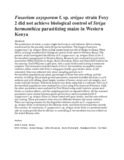| dc.description.abstract | The production of maize, a major staple food crop in sub-Saharan Africa is being constrained by the parasitic weed Striga hermonthica. The fungus Fusarium oxysporum f. sp. strigae (Foxy 2) that causes fusarium wilt of Striga in Ghana, West Africa, is being considered for biological control of the weed in Western Kenya. The present study investigated the efficacy of F. oxysporum f. sp. strigae (Foxy 2) for S. hermonthica management in Western Kenya. Research was conducted in post-entry quarantine (PEQ) facilities at Alupe, Busia, Homabay, Kibos and Siaya field stations for two seasons. Each PEQ was a split-plot, with 4 main blocks each having 6 treatment subplots. The treatments included seeds of two S. hermonthica-susceptible maize varieties, either coated with Foxy 2 using gum Arabic, gum Arabic alone, or left untreated. Data was collected over seven sampling periods on S. hermonthica population per plant, percentage of those that were wilting, and the severity of wilting. Maize plant growth parameters assessed included duration to 50% anthesis and 50% silking, plant height, number of leaves, stover and cob weights, and maize yield per hectare. Statistical analysis was done using SAS 9.1 software. Data on S. hermonthica population were analyzed by χ2-test using Proc Genmod (Poisson); while the other parameters were analyzed by Proc Mixed using study location, season and blocks as random effects, and the sampling periods as repeated effects. All the assessed parameters were similar between plants grown from seeds inoculated with F. oxysporum f. sp. strigae (Foxy 2), those coated with gum Arabic, and the ones without any coating. These parameters were also not different between the maize varieties. There are varying reasons for the disparities between results on F. oxysporum f. sp. strigae (Foxy 2) obtained in this Kenyan study, and those from researches outside this country. In conclusion, F. oxysporum f. sp. strigae strain Foxy 2 is predominantly safe on maize growth, but its efficacy in controlling S. hermonthica was not evident on the tested Kenyan soils. | en_US |
| dc.subject | Fusarium, oxysporum f. sp. Strigae, strain, Foxy 2, achieve, biological, control, Striga, hermonthica, parasitizing, maize, Western | en_US |

